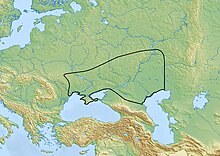You can help expand this article with text translated from the corresponding article in Russian. (November 2018) Click [show] for important translation instructions.
|
 | |
| Geographical range | Pontic steppe |
|---|---|
| Period | Bronze Age |
| Dates | ca. 1900 BC – 1200 BC |
| Preceded by | Abashevo culture, Multi-cordoned ware culture, Sintashta culture, Lola culture |
| Followed by | Noua-Sabatinovka culture, Trzciniec culture, Belozerka culture, Bondarikha culture, Scythians, Sauromatians |
The Srubnaya culture (Russian: Срубная культура, romanized: Srubnaya kul'tura, Ukrainian: Зрубна культура, romanized: Zrubna kul'tura), also known as Timber-grave culture, was a Late Bronze Age 1900–1200 BC culture[1][2][3] in the eastern part of the Pontic–Caspian steppe. It is a successor of the Yamna culture, the Catacomb culture and the Poltavka culture. It is co-ordinate and probably closely related to the Andronovo culture, its eastern neighbor.[3] Whether the Srubnaya culture originated in the east, west, or was a local development, is disputed among archaeologists.[3]
The Srubnaya culture is generally associated with archaic Iranian-speakers.[3][4] The name comes from Russian сруб (srub), "timber framework", from the way graves were constructed.
- ^ Brown, Dorcas, and David Anthony, (2017). "Bronze Age Economy and Rituals at Krasnosamarskoe in the Russian Steppes", in: The Digital Archaeological Record: "...Particular attention focuses on the role of agriculture during the unusual episode of sedentary, settled pastoralism that spread across the Eurasian steppes with the Srubnaya and Andronovo cultures (1900-1200 BC)..."
- ^ Parpola, Asko, (2012). "Formation of the Indo-European and Uralic (Finno-Ugric) language families in the light of archaeology: Revised and integrated ‘total’ correlations", in Mémoires de la Société Finno-Ougrienne, Helsinki, p. 140.
- ^ a b c d Mallory & Adams 1997, pp. 541–542.
- ^ Kuzmina 2007, p. 452.